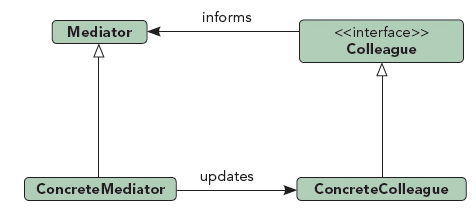标签:初始 als 模式 逻辑 ase hang 传递 描述 怎么
有一个手机仓储管理系统,使用者有三方:销售、仓库管理员、采购。需求是:销售一旦达成订单,销售人员会通过系统的销售子系统部分通知仓储子系统,仓储子系统会将可出仓手机数量减少,同时通知采购管理子系统当前销售订单;仓储子系统的库存到达阈值以下,会通知销售子系统和采购子系统,并督促采购子系统采购;采购完成后,采购人员会把采购信息填入采购子系统,采购子系统会通知销售子系统采购完成,并通知仓库子系统增加库存。
从需求描述来看,每个子系统都和其它子系统有所交流,在设计系统时,如果直接在一个子系统中集成对另两个子系统的操作,一是耦合太大,二是不易扩展。为解决这类问题,我们需要引入一个新的角色-中介者-来将“网状结构”精简为“星形结构”。(为充分说明设计模式,某些系统细节暂时不考虑,例如:仓库满了怎么办该怎么设计。类似业务性的内容暂时不考虑)
首先构造三个子系统,即三个类(在中介者模式中,这些类叫做同事些)
class colleague():
mediator = None
def __init__(self,mediator):
self.mediator = mediator
class purchaseColleague(colleague):
def buyStuff(self,num):
print "PURCHASE:Bought %s"%num
self.mediator.execute("buy",num)
def getNotice(self,content):
print "PURCHASE:Get Notice--%s"%content
class warehouseColleague(colleague):
total=0
threshold=100
def setThreshold(self,threshold):
self.threshold=threshold
def isEnough(self):
if self.total<self.threshold:
print "WAREHOUSE:Warning...Stock is low... "
self.mediator.execute("warning",self.total)
return False
else:
return True
def inc(self,num):
self.total+=num
print "WAREHOUSE:Increase %s"%num
self.mediator.execute("increase",num)
self.isEnough()
def dec(self,num):
if num>self.total:
print "WAREHOUSE:Error...Stock is not enough"
else:
self.total-=num
print "WAREHOUSE:Decrease %s"%num
self.mediator.execute("decrease",num)
self.isEnough()
class salesColleague(colleague):
def sellStuff(self,num):
print "SALES:Sell %s"%num
self.mediator.execute("sell",num)
def getNotice(self, content):
print "SALES:Get Notice--%s" % content
当各个类在初始时都会指定一个中介者,而各个类在有变动时,也会通知中介者,由中介者协调各个类的操作。
中介者实现如下
class abstractMediator():
purchase=""
sales=""
warehouse=""
def setPurchase(self,purchase):
self.purchase=purchase
def setWarehouse(self,warehouse):
self.warehouse=warehouse
def setSales(self,sales):
self.sales=sales
def execute(self,content,num):
pass
class stockMediator(abstractMediator):
def execute(self,content,num):
print "MEDIATOR:Get Info--%s"%content
if content=="buy":
self.warehouse.inc(num)
self.sales.getNotice("Bought %s"%num)
elif content=="increase":
self.sales.getNotice("Inc %s"%num)
self.purchase.getNotice("Inc %s"%num)
elif content=="decrease":
self.sales.getNotice("Dec %s"%num)
self.purchase.getNotice("Dec %s"%num)
elif content=="warning":
self.sales.getNotice("Stock is low.%s Left."%num)
self.purchase.getNotice("Stock is low. Please Buy More!!! %s Left"%num)
elif content=="sell":
self.warehouse.dec(num)
self.purchase.getNotice("Sold %s"%num)
else:
pass
中介者模式中的execute是最重要的方法,它根据同事类传递的信息,直接协调各个同事的工作。
在场景类中,设置仓储阈值为200,先采购300,再卖出120,实现如下
if __name__=="__main__":
mobile_mediator=stockMediator()#先配置
mobile_purchase=purchaseColleague(mobile_mediator)
mobile_warehouse=warehouseColleague(mobile_mediator)
mobile_sales=salesColleague(mobile_mediator)
mobile_mediator.setPurchase(mobile_purchase)
mobile_mediator.setWarehouse(mobile_warehouse)
mobile_mediator.setSales(mobile_sales)
mobile_warehouse.setThreshold(200)
mobile_purchase.buyStuff(300)
mobile_sales.sellStuff(120)
打印结果如下:
PURCHASE:Bought 300
MEDIATOR:Get Info--buy
WAREHOUSE:Increase 300
MEDIATOR:Get Info--increase
SALES:Get Notice--Inc 300
PURCHASE:Get Notice--Inc 300
SALES:Get Notice--Bought 300
SALES:Sell 120
MEDIATOR:Get Info--sell
WAREHOUSE:Decrease 120
MEDIATOR:Get Info--decrease
SALES:Get Notice--Dec 120
PURCHASE:Get Notice--Dec 120
WAREHOUSE:Warning...Stock is low...
MEDIATOR:Get Info--warning
SALES:Get Notice--Stock is low.180 Left.
PURCHASE:Get Notice--Stock is low. Please Buy More!!! 180 Left
PURCHASE:Get Notice--Sold 120
中介者模式的定义为:用一个中介对象封装一系列的对象交互。中介者使各对象不需要显式地互相作用,从而使其耦合松散,并可以独立地改变它们之间的交互。

1、减少类与类的依赖,降低了类和类之间的耦合 2、容易扩展规模
设计类图时,出现了网状结构时,可以考虑将类图设计成星型结构,这样就可以使用中介者模式了。如机场调度系统(多个跑道、飞机、指挥塔之间的调度)、路由系统;著名的MVC框架中,其中的C(Controller)就是M(Model)和V(View)的中介者
中介者本身的复杂性可能会很大,例如,同事类的方法如果很多的话,本例中的execute逻辑会很复杂。
标签:初始 als 模式 逻辑 ase hang 传递 描述 怎么
原文地址:https://www.cnblogs.com/596014054-yangdongsheng/p/10288554.html